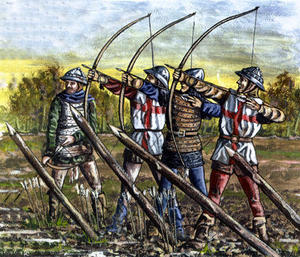In the (old) trenchesThe guns versus bows puzzle solved
In Western Europe, military bows became obsolete during the sixteenth century as firearms evolved; in China, however, guns and bows coexisted for almost a millennium; now one scientist thinks he knows why: it was easier to train musketeers than to train good archers, and the composite materials from which good bows were made did not fare well in humid conditions

English longbowmen at Agincourt // Source: dailymail.co.uk
Here is a puzzle for students of weaponry: At the Battle of Agincourt in 1415, an English army of 6,000 soldiers led by Henry V, defeated a French army of 36,000.
One crucial element in this victory was the longbow. Henry deployed some 5,000 longbowmen, whereas the French used mainly crossbows, which have a much shorter range. Largely because of this, the French lost as many as 10,000 soldiers to England’s 112.
Despite the clear utility of the longbow as a weapon of war, it soon became obsolete as firearms evolved. Within 200 years of Agincourt, it had fallen out of military use almost entirely. Yet, in China, weaponry evolved in an entirely different way. Here, firearms were used much earlier. In 1232, the Mongol army used firearms as armor piercing weapons during the siege of Pien in China (now known as Khai-Fun Fu). Firearms may have also been in use much earlier. One picture dating from the tenth century shows a demon wielding a gun of sorts.
Yet, Chinese armies still used bows some 800 years later. How come?
Technology Review reports that Timo Nieminen, a physicist at the University of Queensland in Brisbane, describes the evolution of the Asian composite war bow, a device he describes as “the best bow available before the advent of modern materials and the modern compound bow.” In the process, he throws some light on this question, explaining why the bow was much harder to make obsolete in China.
When a bow is drawn, the surface closest to the archer becomes compressed, while the opposite surface is placed in tension. That puts extreme demands on whatever material is used for the limb. Nieminen says it is hugely difficult to find a single material that provides sufficient strength under both tension and compression, while also allowing a high degree of deformation.
The solution that Asian bowyers settled on was the composite bow in which the surface under compression is made of horn and the surface in tension made of resin-sinew composite, both joined to a central portion of wood.
These bows were enormously difficult to make. By some accounts, the drying process for the resin took over a year. When they were finished, though, they vastly outperformed other bows. This type of bow has been used in China for at least 2,000 years.
One key factor in the performance of a bow is size to draw length ratio. The draw length is generally about as long as an archer’s arm. Because wood cannot be greatly deformed before it breaks, a wooden bow must be at least 2.3 times its draw length. So English longbows had to be about as long as the archer was tall and Japanese longbows were 200 centimeter long.
By comparison, the Asian composite bow was only 110 centimeter long, while achieving a similar performance.
That meant the bow was lighter and easier to carry than its European cousins (Nieminen goes on to give a quick and fascinating account of the physics of bows).
The Asian composite bow, however, had one weakness that prevented it from spreading to Europe, says Nieminen. Its composite materials did not fare well in humid conditions. For that reason, the weapons never spread south to India nor would they have survived land or sea crossings back to Europe.
Nevertheless, both East and Western designs were much more accurate than early firearms, particularly over longer distances. They had a much higher rate of fire, and they required fewer materials and logistics to manufacture and supply. Surely, any military commander would have preferred them over firearms.
Well, yes — except for one big disadvantage: bows require a high degree of skill to use proficiently.
Nieminen points out that while Chinese armies had a huge pool of skilled archers to pick from, European armies did not. The Europeans therefore trained their soldiers to use firearms, which could be done relatively quickly.
For that reason, firearms quickly eclipsed the bow in Europe. “Economic and social factors, especially the training of musketeers as opposed to archers, were more important factors influencing the replacement of the bow by the gun than pure military ‘effectiveness,’” says Nieminen.
This is why the bow the gun co-existed for so long in China. Puzzle solved.
— Read more in Timo A. Nieminen, “The Asian war bow,” in E. Barbiero, P. Hannaford, and D. Moss, eds., 19th Australian Institute of Physics Congress, ACOFTAOS, 2010. [Unpaginated, CD-ROM, ISBN 978-0-9775657-6-4] arXiv:1101.1677v1 [physics.hist-ph]
